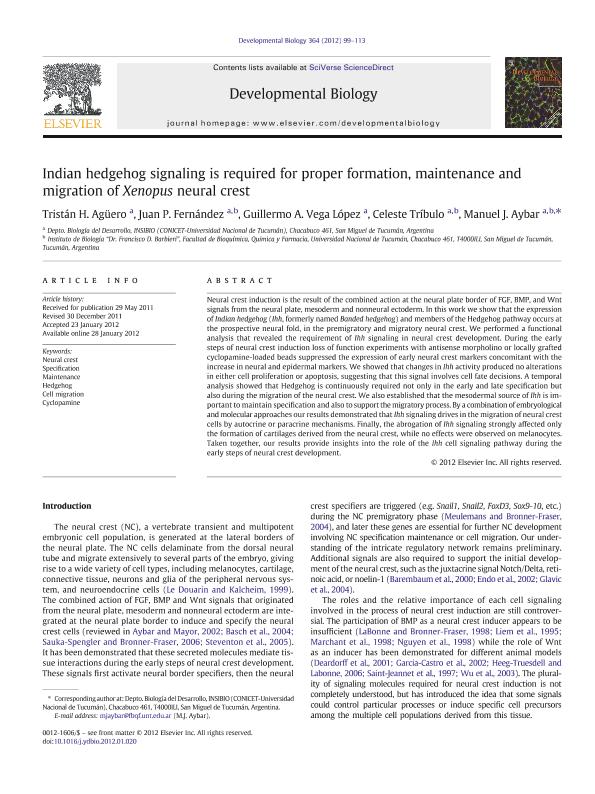Mostrar el registro sencillo del ítem
dc.contributor.author
Agüero, Tristán Horacio

dc.contributor.author
Fernández, Juan Pablo

dc.contributor.author
Vega López, Guillermo Alfredo

dc.contributor.author
Tríbulo, Celeste

dc.contributor.author
Aybar, Manuel Javier

dc.date.available
2018-09-24T14:42:55Z
dc.date.issued
2012-04
dc.identifier.citation
Agüero, Tristán Horacio; Fernández, Juan Pablo; Vega López, Guillermo Alfredo; Tríbulo, Celeste; Aybar, Manuel Javier; Indian hedgehog signaling is required for proper formation, maintenance and migration of Xenopus neural crest; Academic Press Inc Elsevier Science; Developmental Biology; 364; 2; 4-2012; 99-113
dc.identifier.issn
0012-1606
dc.identifier.uri
http://hdl.handle.net/11336/60718
dc.description.abstract
Neural crest induction is the result of the combined action at the neural plate border of FGF, BMP, and Wnt signals from the neural plate, mesoderm and nonneural ectoderm. In this work we show that the expression of Indian hedgehog (Ihh, formerly named Banded hedgehog) and members of the Hedgehog pathway occurs at the prospective neural fold, in the premigratory and migratory neural crest. We performed a functional analysis that revealed the requirement of Ihh signaling in neural crest development. During the early steps of neural crest induction loss of function experiments with antisense morpholino or locally grafted cyclopamine-loaded beads suppressed the expression of early neural crest markers concomitant with the increase in neural and epidermal markers. We showed that changes in Ihh activity produced no alterations in either cell proliferation or apoptosis, suggesting that this signal involves cell fate decisions. A temporal analysis showed that Hedgehog is continuously required not only in the early and late specification but also during the migration of the neural crest. We also established that the mesodermal source of Ihh is important to maintain specification and also to support the migratory process. By a combination of embryological and molecular approaches our results demonstrated that Ihh signaling drives in the migration of neural crest cells by autocrine or paracrine mechanisms. Finally, the abrogation of Ihh signaling strongly affected only the formation of cartilages derived from the neural crest, while no effects were observed on melanocytes. Taken together, our results provide insights into the role of the Ihh cell signaling pathway during the early steps of neural crest development. © 2012 Elsevier Inc.
dc.format
application/pdf
dc.language.iso
eng
dc.publisher
Academic Press Inc Elsevier Science

dc.rights
info:eu-repo/semantics/openAccess
dc.rights.uri
https://creativecommons.org/licenses/by-nc-sa/2.5/ar/
dc.subject
Cell Migration
dc.subject
Cyclopamine
dc.subject
Hedgehog
dc.subject
Maintenance
dc.subject
Neural Crest
dc.subject
Specification
dc.subject.classification
Otras Ciencias Biológicas

dc.subject.classification
Ciencias Biológicas

dc.subject.classification
CIENCIAS NATURALES Y EXACTAS

dc.title
Indian hedgehog signaling is required for proper formation, maintenance and migration of Xenopus neural crest
dc.type
info:eu-repo/semantics/article
dc.type
info:ar-repo/semantics/artículo
dc.type
info:eu-repo/semantics/publishedVersion
dc.date.updated
2018-09-24T14:02:04Z
dc.journal.volume
364
dc.journal.number
2
dc.journal.pagination
99-113
dc.journal.pais
Países Bajos

dc.journal.ciudad
Amsterdam
dc.description.fil
Fil: Agüero, Tristán Horacio. Consejo Nacional de Investigaciones Científicas y Técnicas. Centro Científico Tecnológico Conicet - Tucumán. Instituto Superior de Investigaciones Biológicas. Universidad Nacional de Tucumán. Instituto Superior de Investigaciones Biológicas; Argentina
dc.description.fil
Fil: Fernández, Juan Pablo. Consejo Nacional de Investigaciones Científicas y Técnicas. Centro Científico Tecnológico Conicet - Tucumán. Instituto Superior de Investigaciones Biológicas. Universidad Nacional de Tucumán. Instituto Superior de Investigaciones Biológicas; Argentina. Universidad Nacional de Tucumán. Facultad de Bioquímica, Química y Farmacia; Argentina
dc.description.fil
Fil: Vega López, Guillermo Alfredo. Consejo Nacional de Investigaciones Científicas y Técnicas. Centro Científico Tecnológico Conicet - Tucumán. Instituto Superior de Investigaciones Biológicas. Universidad Nacional de Tucumán. Instituto Superior de Investigaciones Biológicas; Argentina
dc.description.fil
Fil: Tríbulo, Celeste. Consejo Nacional de Investigaciones Científicas y Técnicas. Centro Científico Tecnológico Conicet - Tucumán. Instituto Superior de Investigaciones Biológicas. Universidad Nacional de Tucumán. Instituto Superior de Investigaciones Biológicas; Argentina. Universidad Nacional de Tucumán. Facultad de Bioquímica, Química y Farmacia; Argentina
dc.description.fil
Fil: Aybar, Manuel Javier. Consejo Nacional de Investigaciones Científicas y Técnicas. Centro Científico Tecnológico Conicet - Tucumán. Instituto Superior de Investigaciones Biológicas. Universidad Nacional de Tucumán. Instituto Superior de Investigaciones Biológicas; Argentina
dc.journal.title
Developmental Biology

dc.relation.alternativeid
info:eu-repo/semantics/altIdentifier/doi/https://dx.doi.org/10.1016/j.ydbio.2012.01.020
dc.relation.alternativeid
info:eu-repo/semantics/altIdentifier/url/https://www.sciencedirect.com/science/article/pii/S0012160612000498
Archivos asociados
